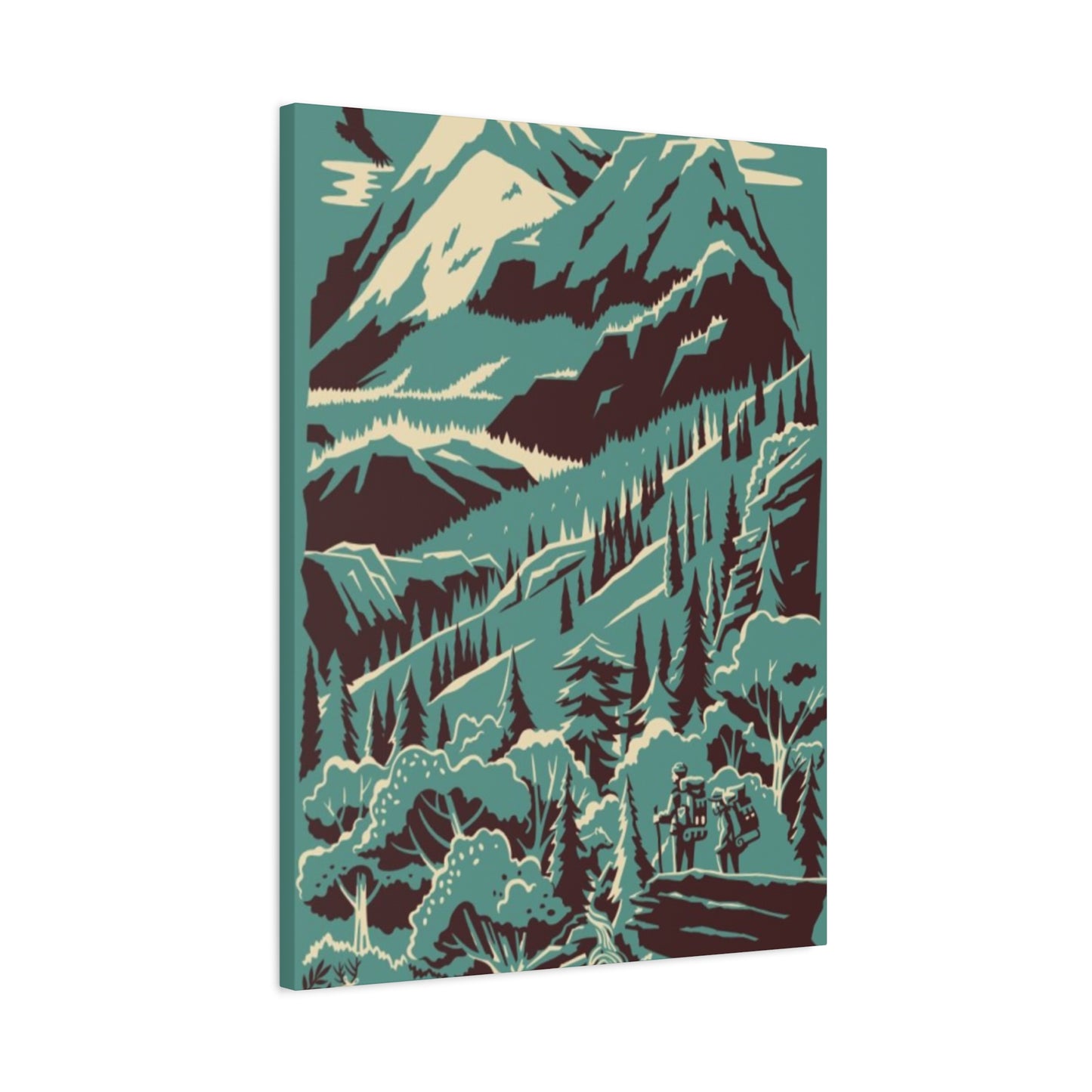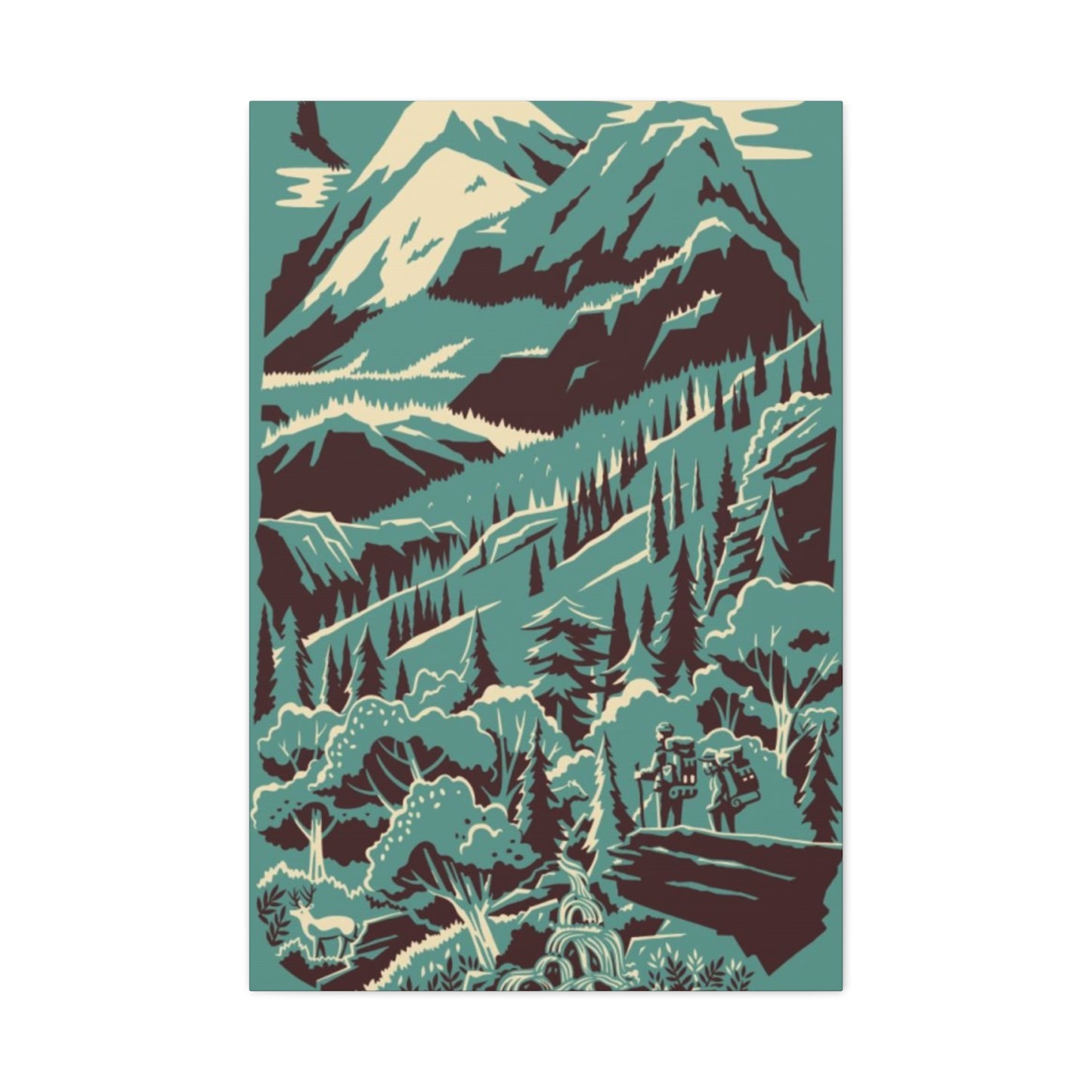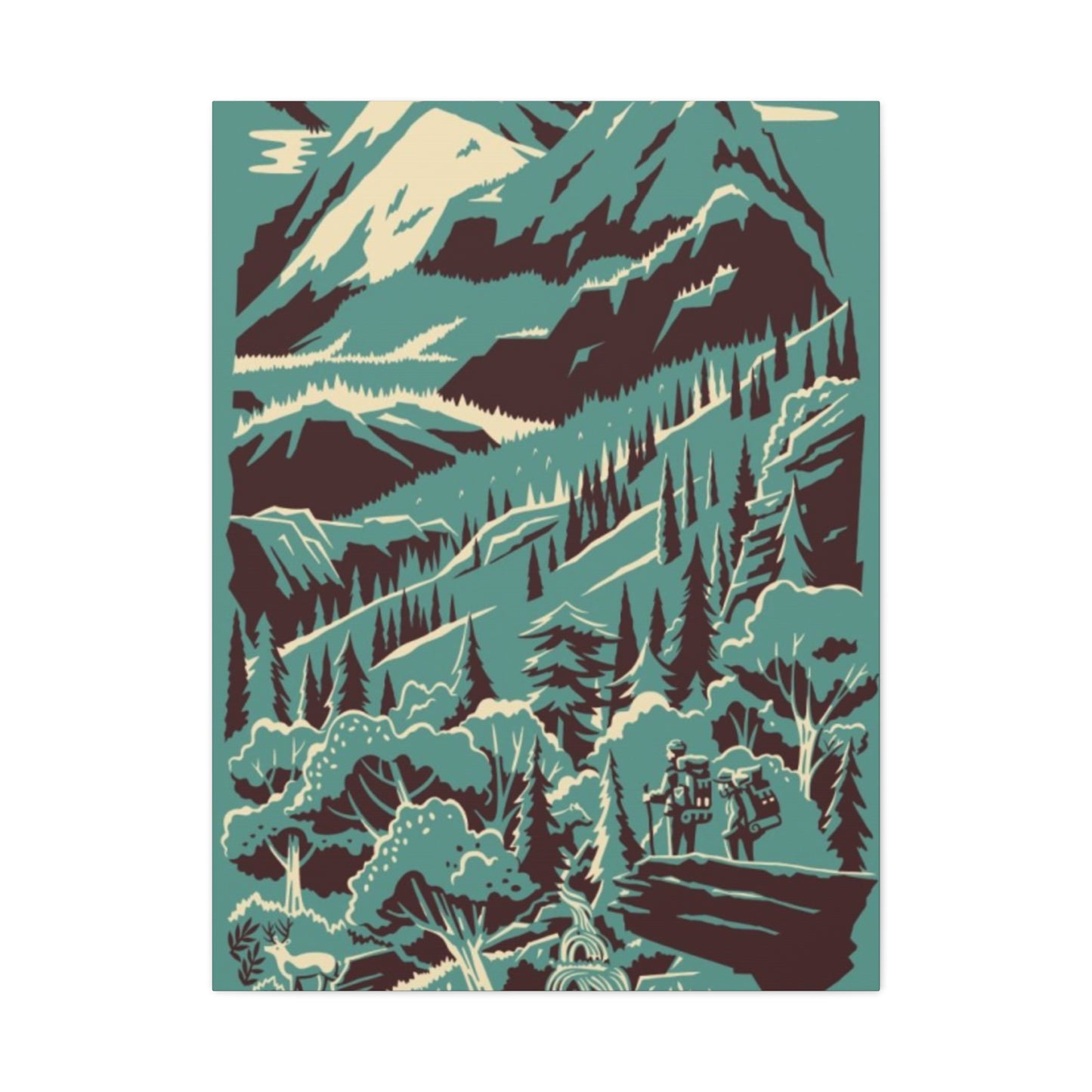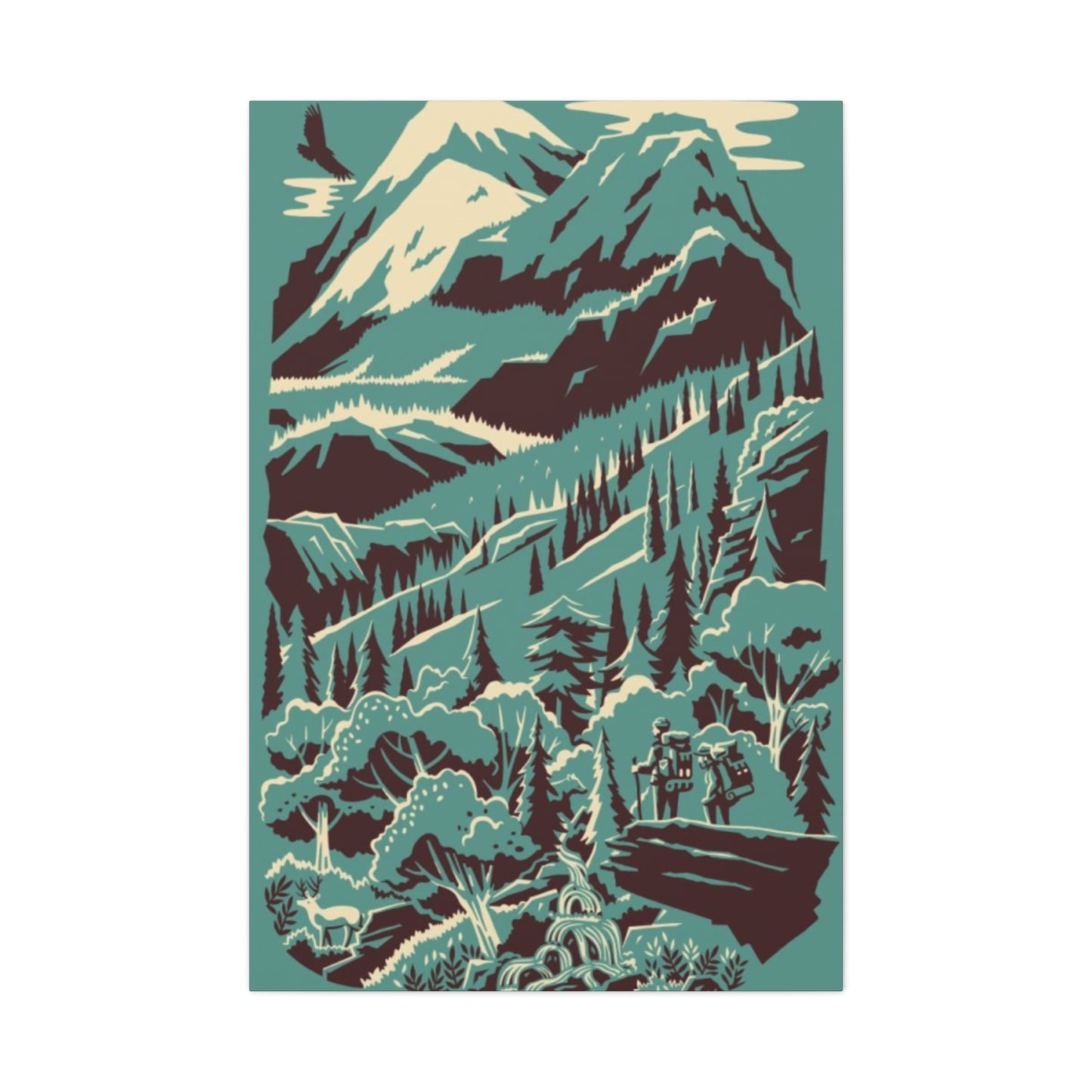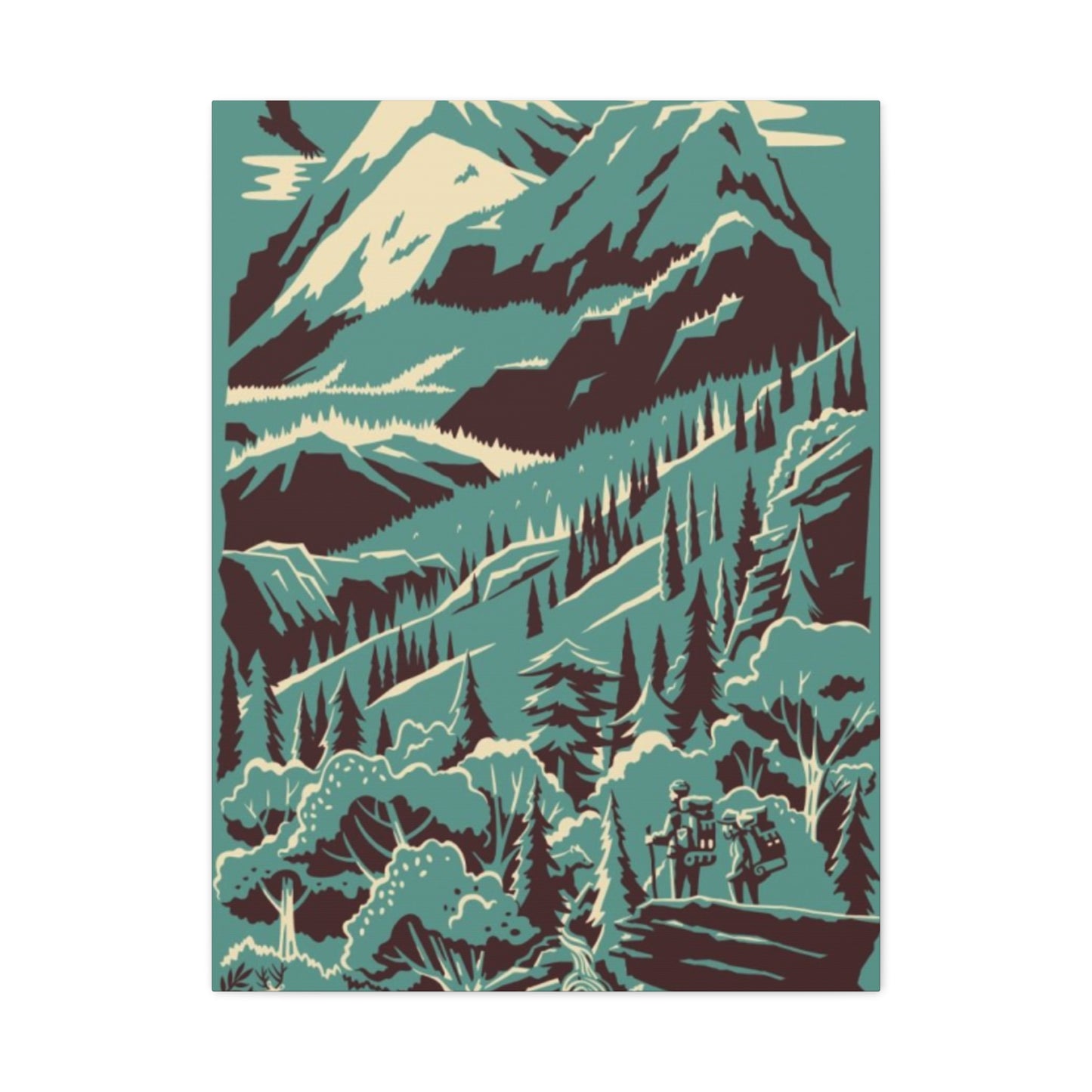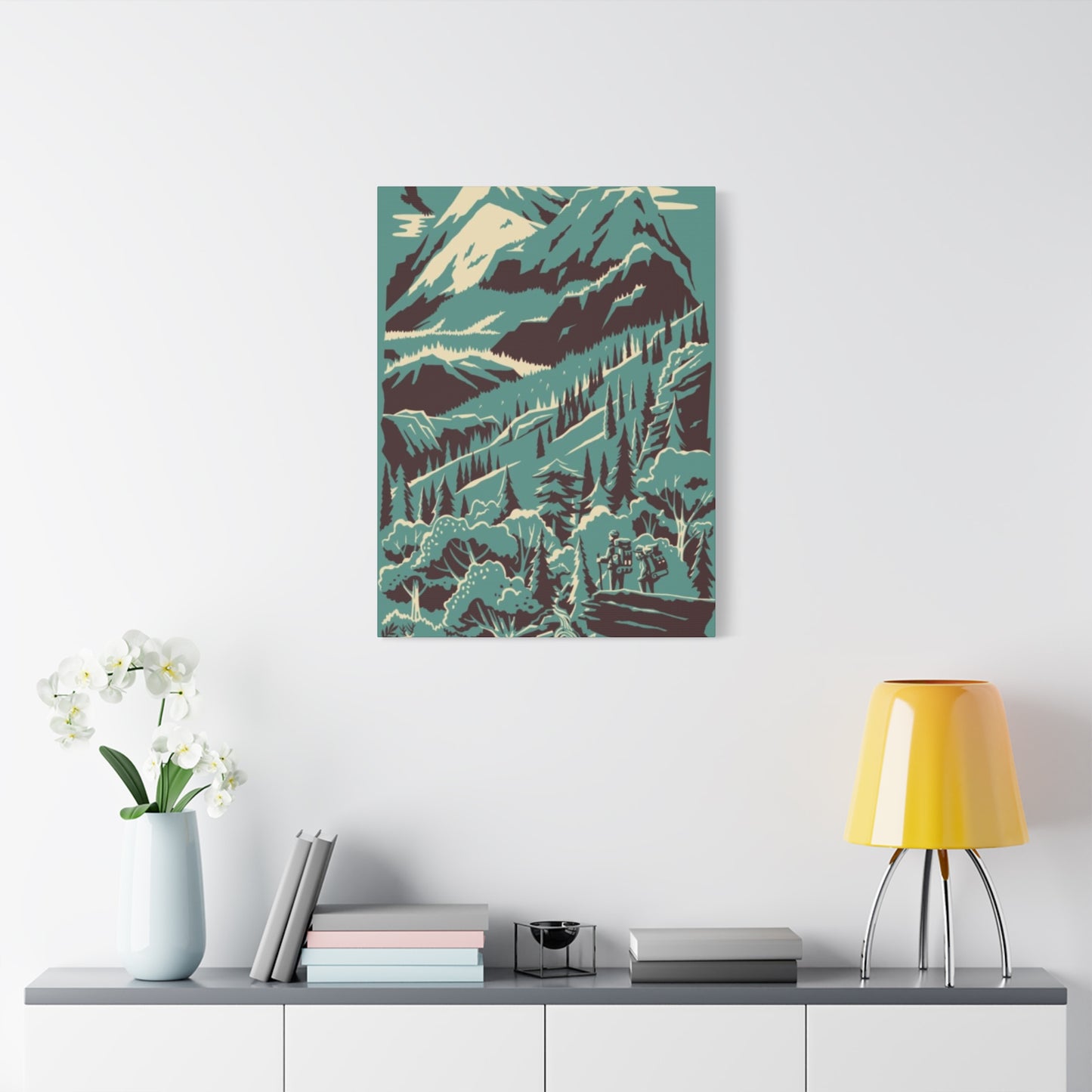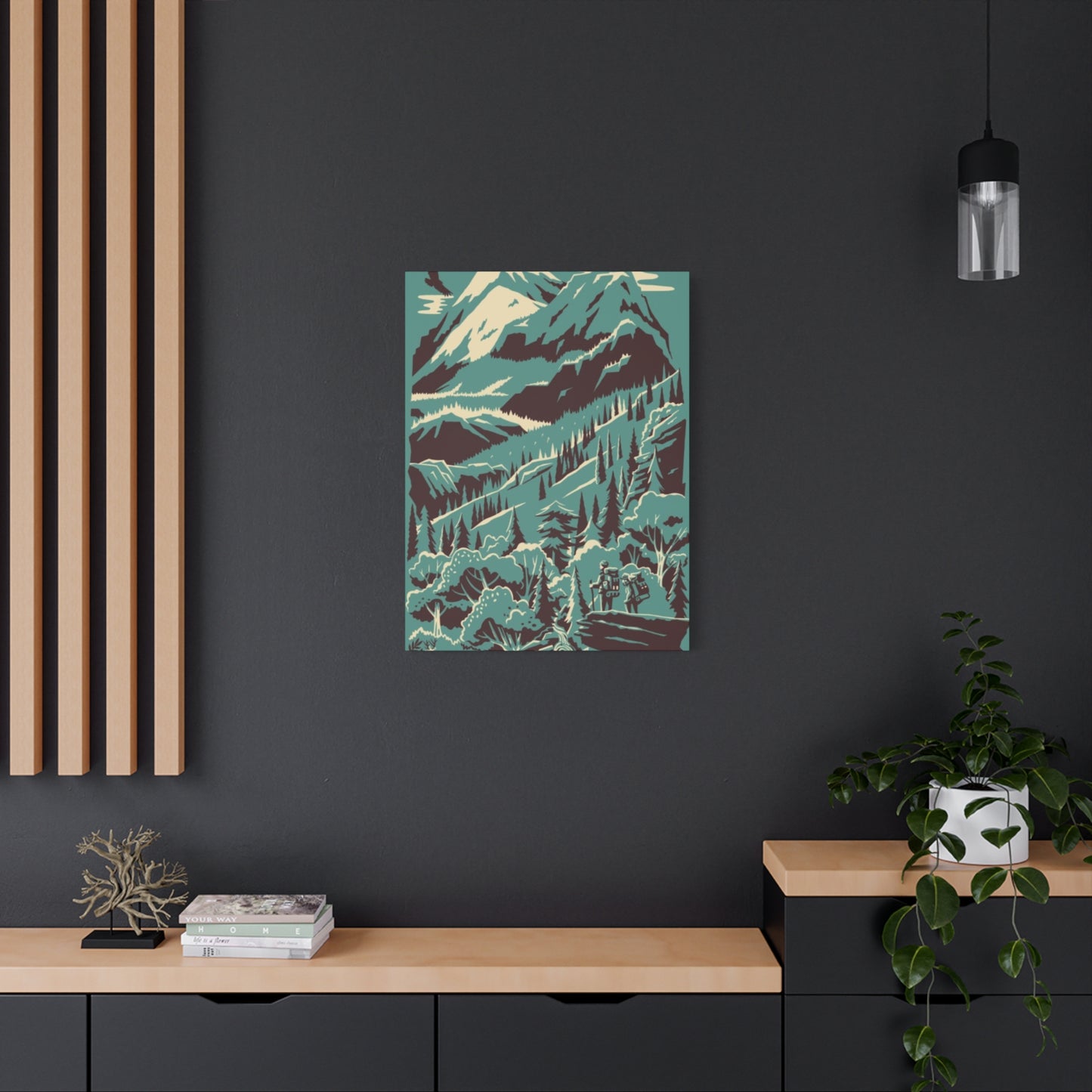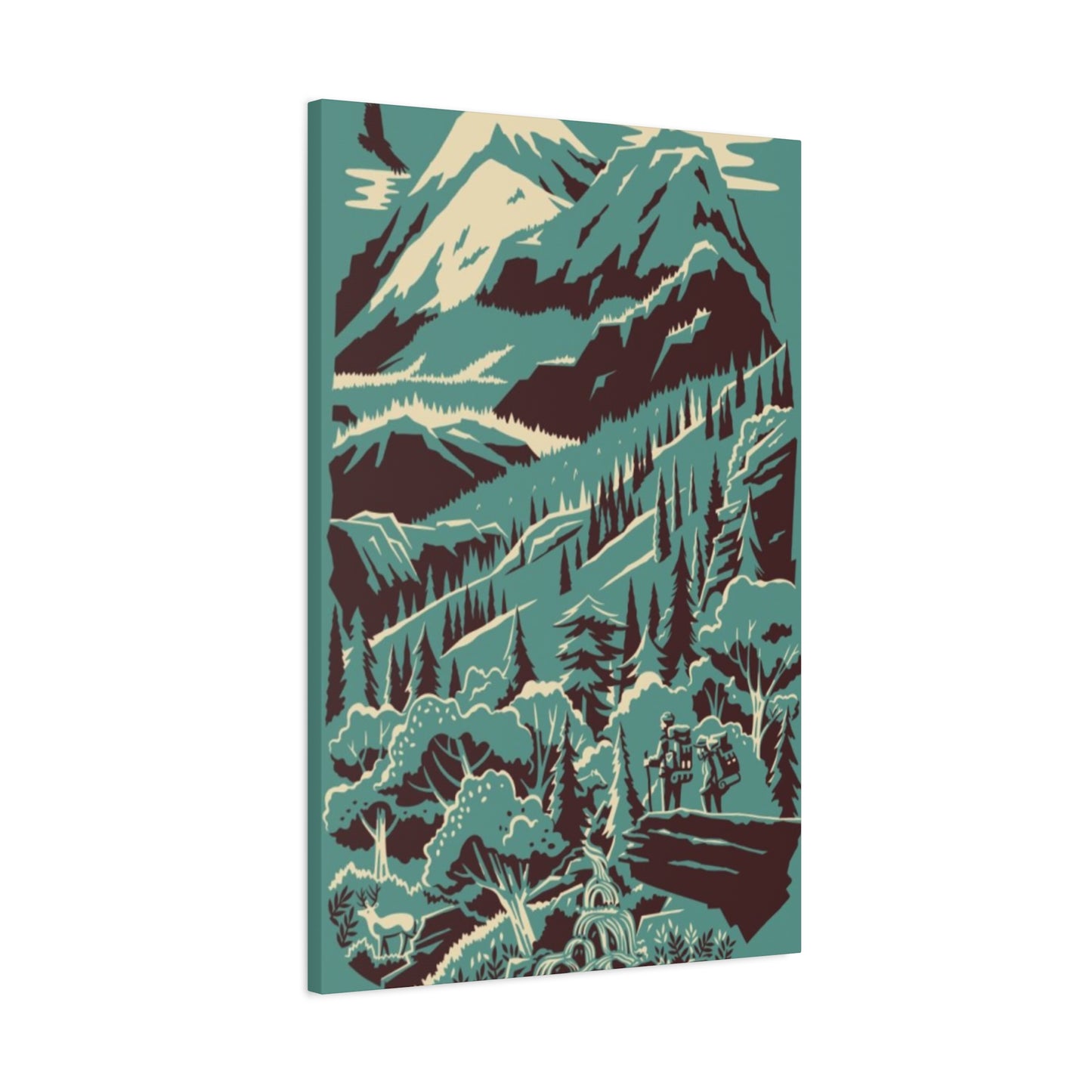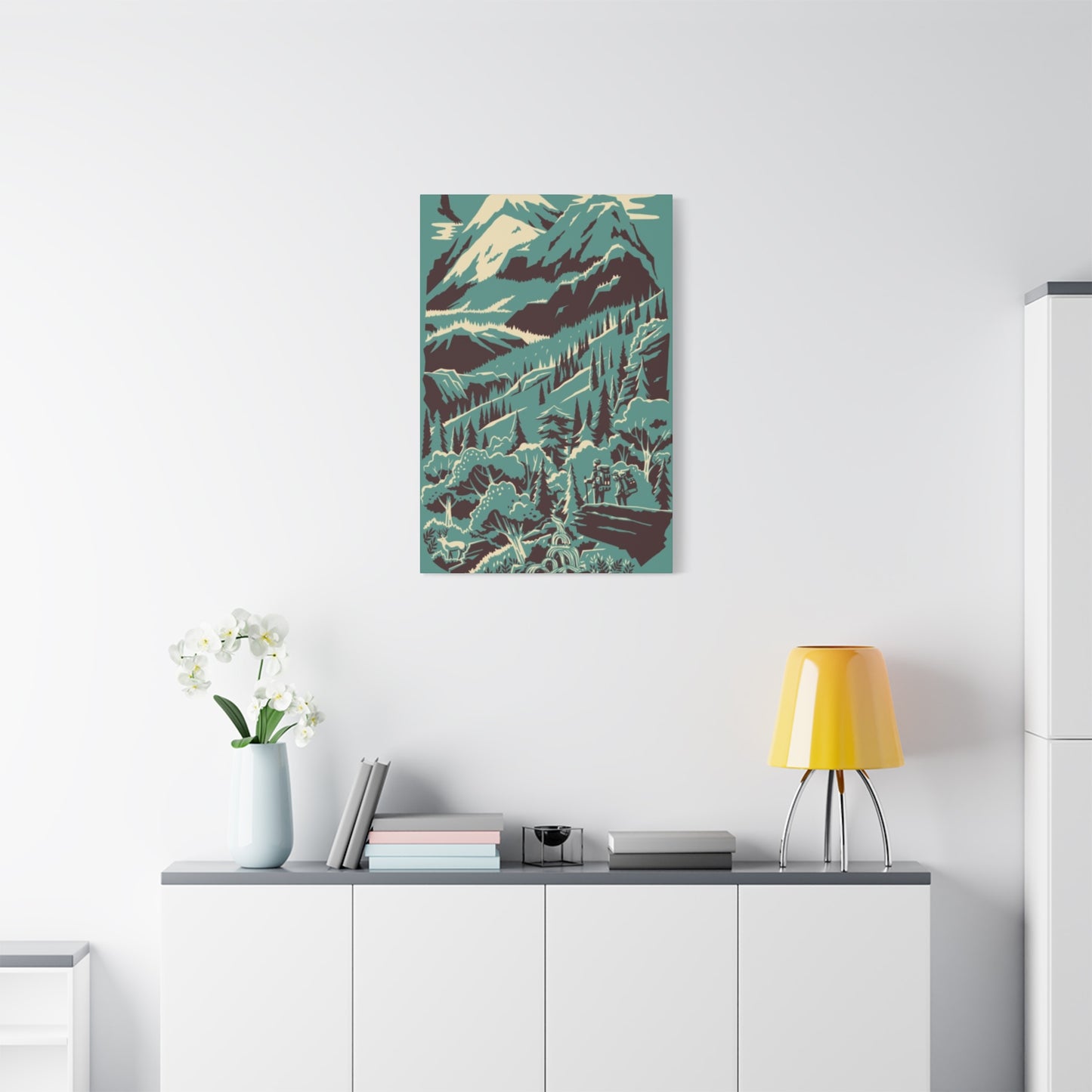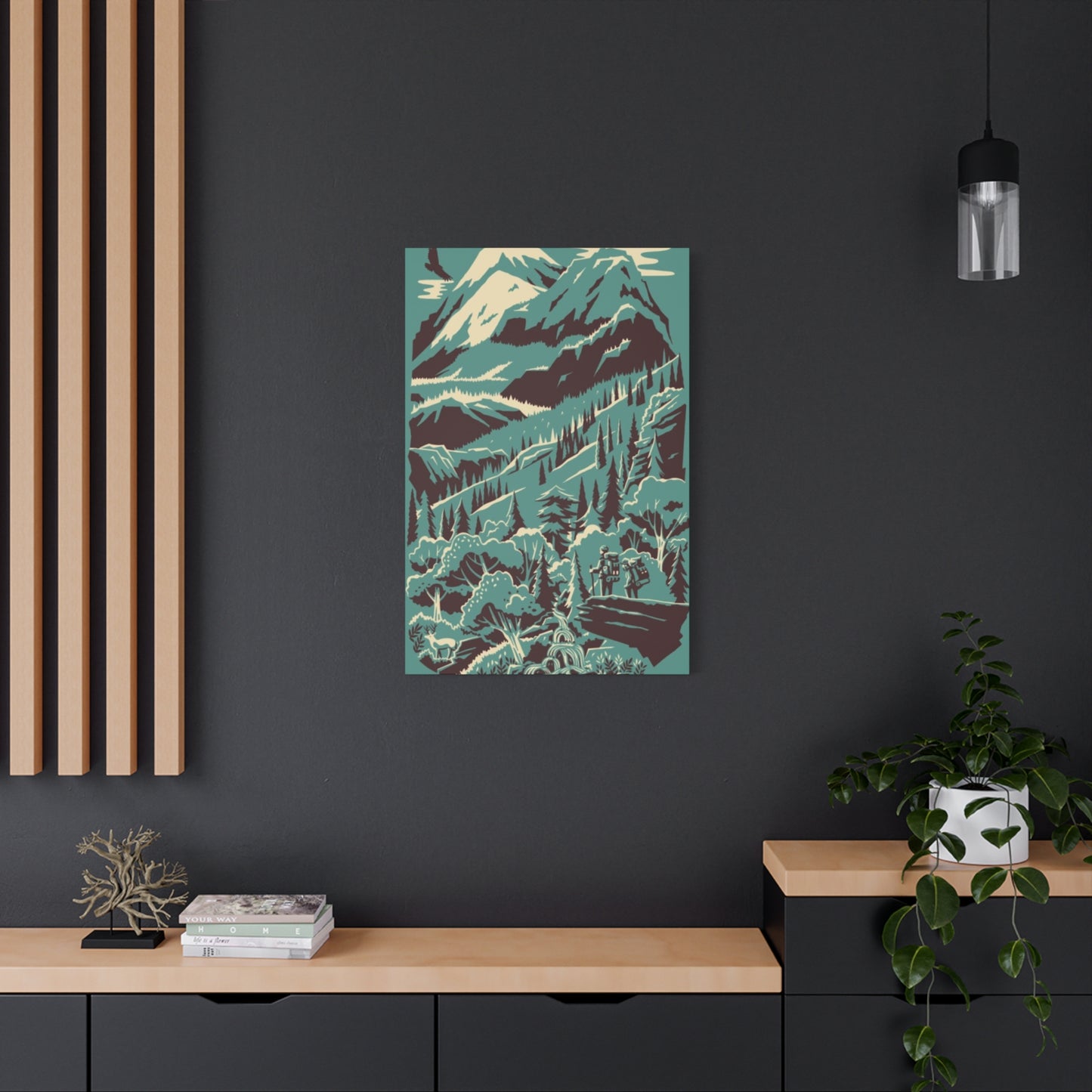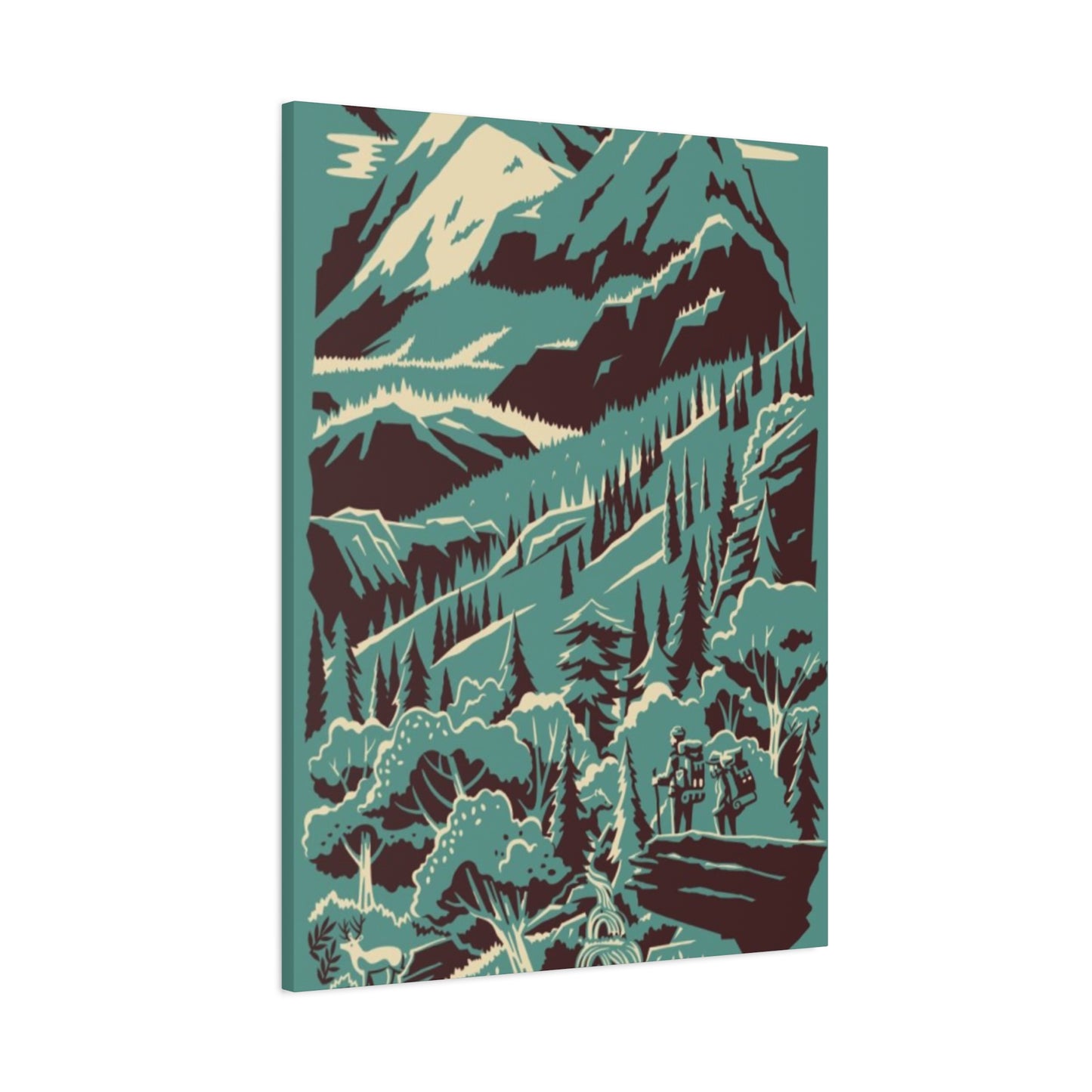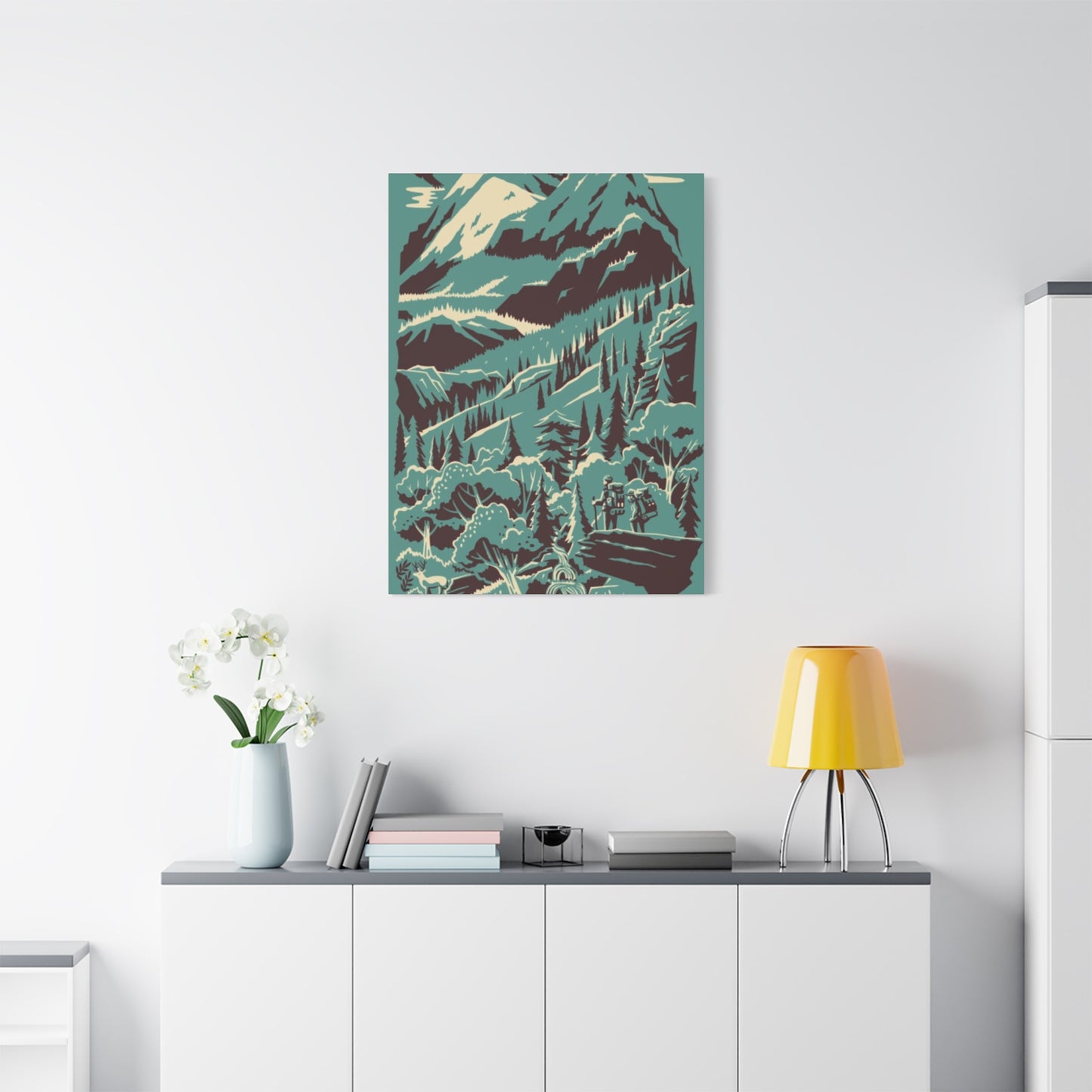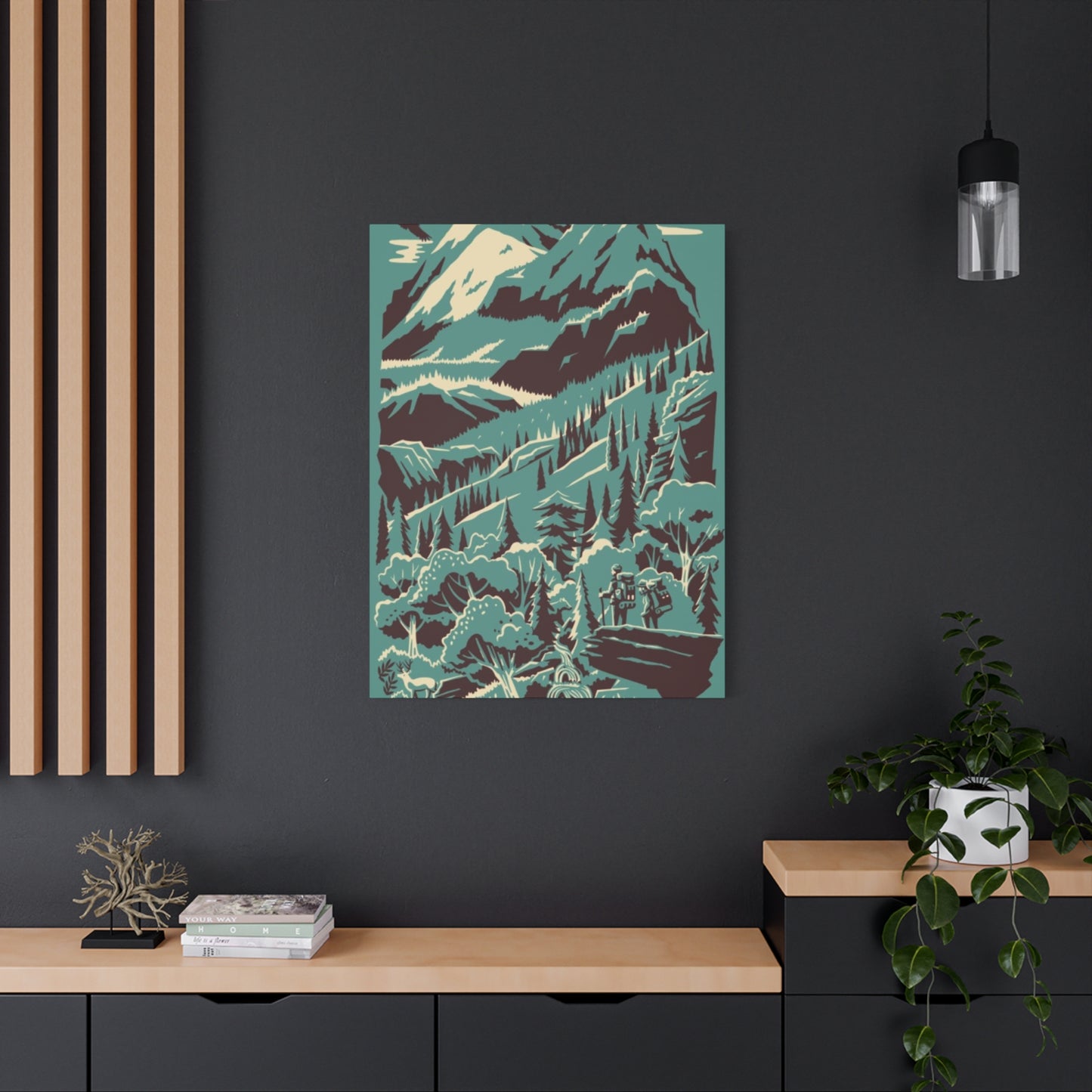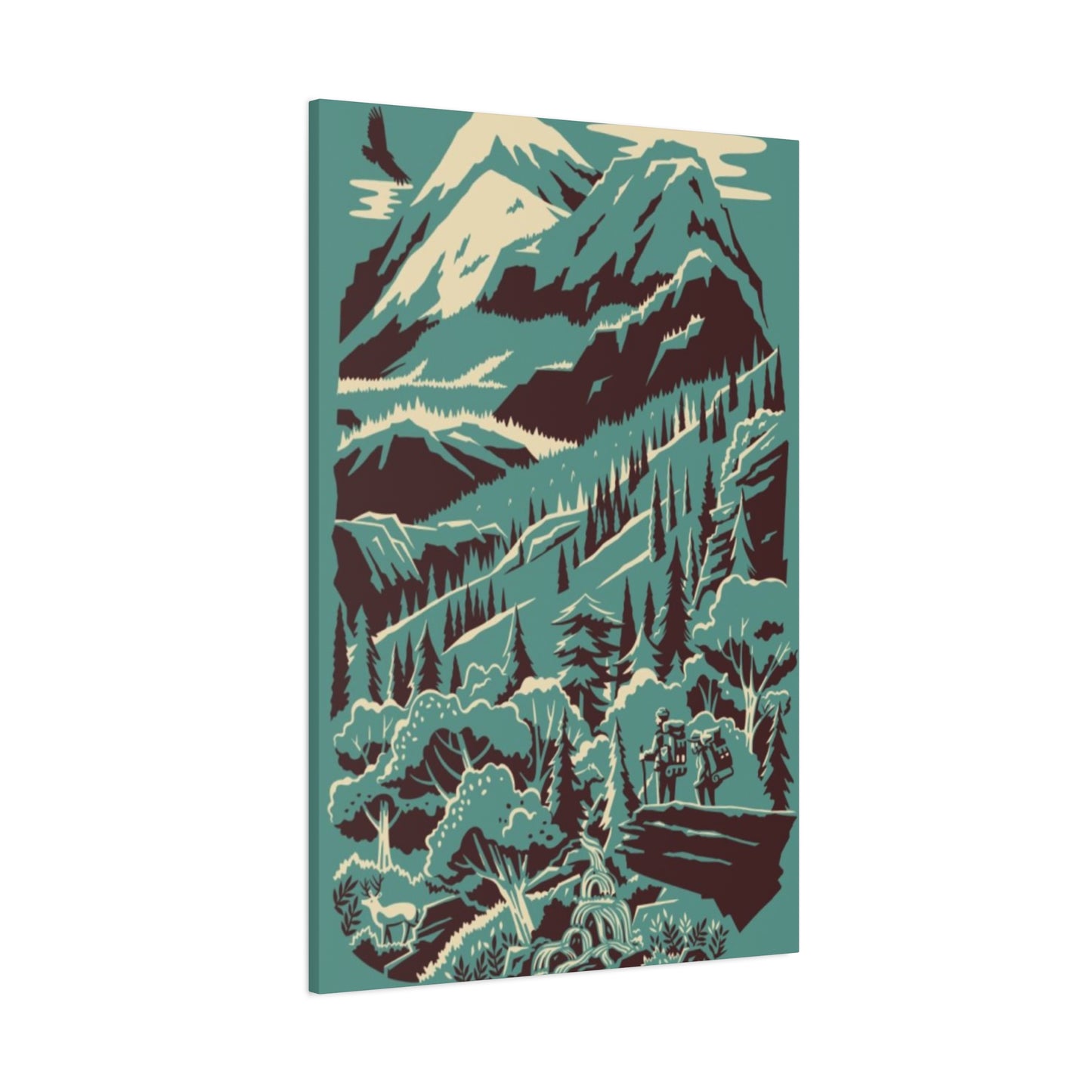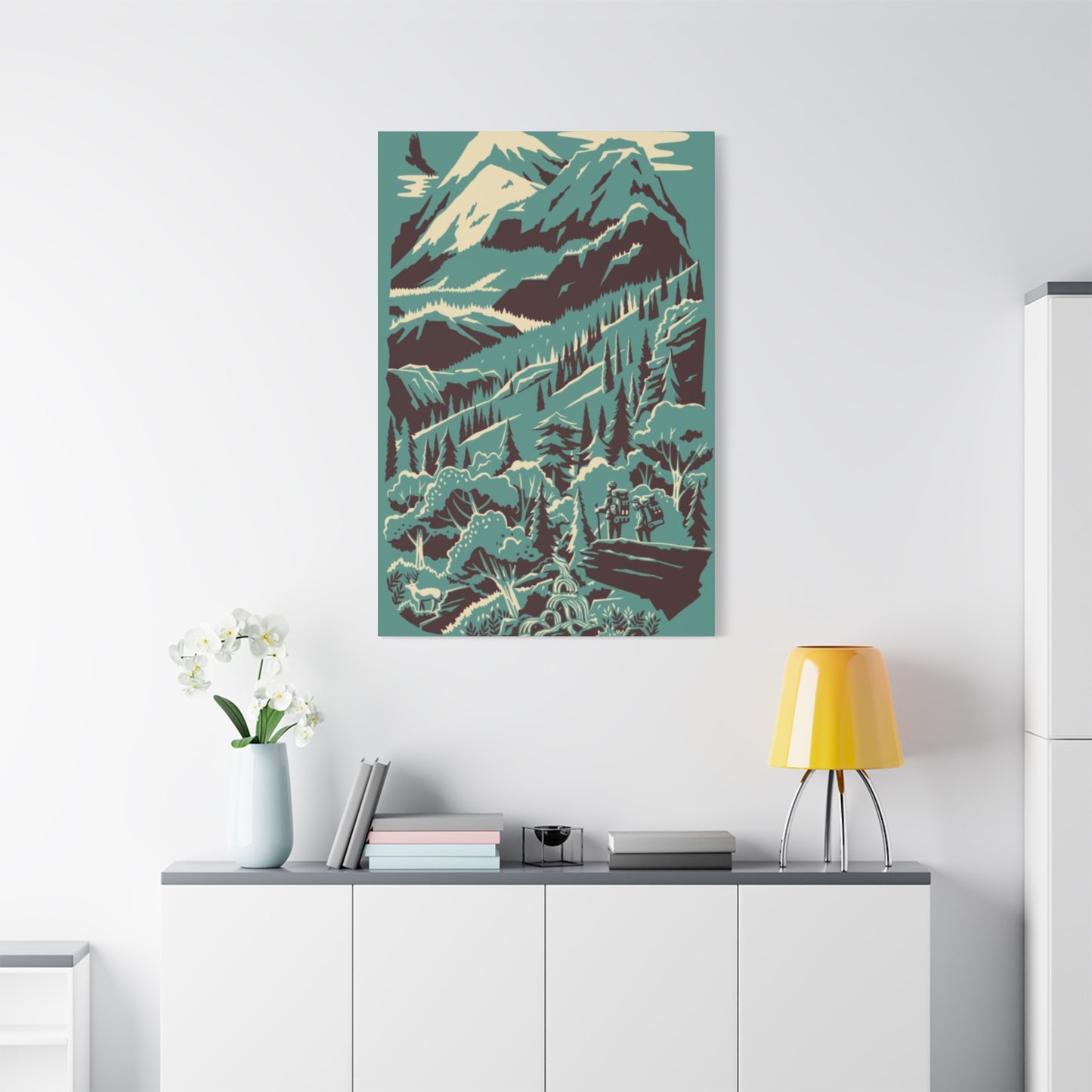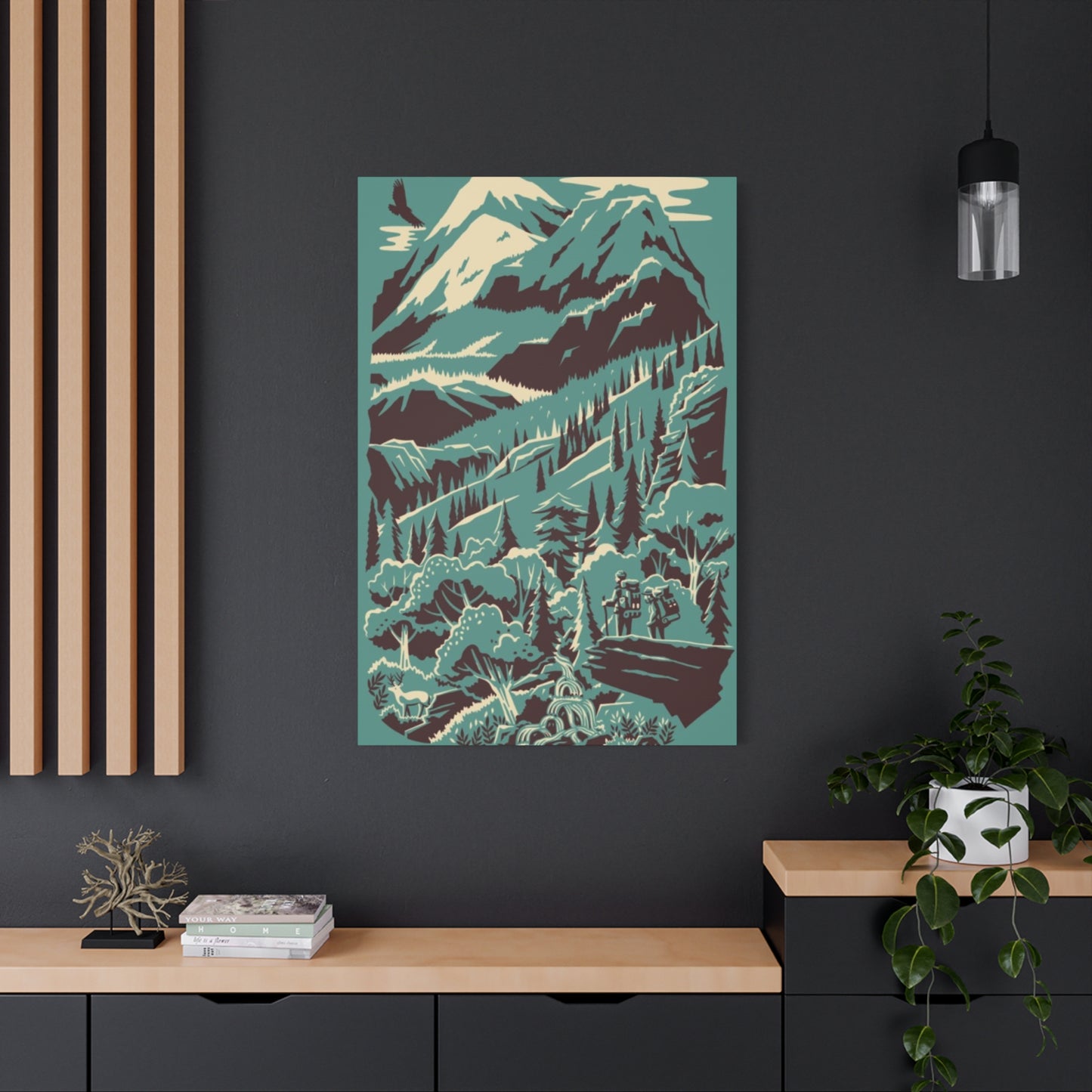Elevate Your Living Space with National Park Wall Art: A Comprehensive Design Journey
Transform your home into a sanctuary of natural wonder by incorporating the breathtaking essence of America's most cherished landscapes through carefully curated canvas artwork. The magnificence of protected wilderness areas offers endless inspiration for interior decoration, allowing you to create spaces that reflect your love for outdoor exploration and environmental preservation. This extensive exploration will guide you through every aspect of selecting, displaying, and celebrating these magnificent natural treasures within your personal living environment.
Stunning National Park Views
The raw power and sublime beauty captured in photographs of protected wilderness areas provide unmatched visual impact for residential and commercial spaces alike. These remarkable vistas showcase geological formations that have evolved over millions of years, presenting nature's architectural mastery in ways that immediately capture attention and imagination. From the dramatic cliffs of coastal reserves to the towering granite faces of mountain sanctuaries, each protected landscape offers distinctive characteristics that can complement various interior design schemes.
When selecting pieces that feature spectacular wilderness vistas, consider the emotional response you want to evoke in each room. Grand panoramic scenes work exceptionally well in living rooms and common areas where they can serve as conversation starters and focal points. The sweeping horizons and vast open spaces depicted in these artworks create a sense of freedom and possibility that can make even modest rooms feel more expansive and inviting.
The technical quality of photography in these pieces matters significantly. Look for artwork that captures the full dynamic range of natural light, from the subtle gradations in morning mist to the brilliant contrast of afternoon sunshine against shadowed valleys. High-resolution images preserve the intricate details that make these locations so remarkable, allowing viewers to discover new elements each time they look at the piece.
Color saturation plays a crucial role in how these artworks integrate with your existing decor. Some spaces benefit from highly saturated, vibrant depictions that energize the room, while others call for more muted, natural tones that create a calming atmosphere. Consider how the dominant colors in the artwork will interact with your furniture, wall colors, and other decorative elements to create a cohesive visual environment.
The perspective from which these landscapes are captured also influences their impact. Elevated viewpoints that show vast territories spread out below create a sense of majesty and accomplishment, similar to the feeling of reaching a summit after a challenging hike. Ground-level perspectives that emphasize the scale of natural features relative to human observers can inspire humility and wonder, reminding us of our place within the larger natural world.
Seasonal variations captured in these artworks offer opportunities to rotate your decor throughout the year or to freeze a particular moment in time that holds special meaning. Spring blooms, summer greenery, autumn colors, and winter snowscapes each bring their own mood and aesthetic qualities to interior spaces.
Nature's Beauty on Canvas
The translation of outdoor splendor onto fabric-backed surfaces represents a marriage of artistic interpretation and photographic precision. Modern printing technologies have advanced to the point where texture, color depth, and visual clarity rival traditional painting methods while offering durability and affordability that makes these artworks accessible to a broad audience.
Canvas as a medium brings particular advantages to nature imagery. The slight texture of the fabric adds dimensional quality that enhances the organic subject matter, creating a more tactile and engaging viewing experience than flat photographic prints. This texture catches light in subtle ways that change throughout the day as natural and artificial illumination shifts, keeping the artwork visually interesting.
The archival quality of contemporary canvas prints ensures that your investment will maintain its visual appeal for generations. UV-resistant inks prevent fading even in rooms with substantial natural light exposure, while the canvas material itself resists the warping and deterioration that can affect paper-based prints. Proper stretching over wooden frames prevents sagging and maintains the taut surface that showcases the image at its best.
Size considerations become particularly important when working with nature imagery on canvas. Larger pieces allow for more immersive experiences, particularly with panoramic landscapes that benefit from horizontal formats. The scale should be proportional to the wall space and room dimensions, creating visual balance rather than overwhelming or underwhelming the space.
The edges of canvas prints offer creative opportunities for display. Gallery-wrapped edges that continue the image around the sides eliminate the need for traditional framing, creating a contemporary, streamlined appearance. Alternatively, some pieces feature solid-color edges or even complementary imagery on the sides, allowing for creative display options that suit different aesthetic preferences.
Layering multiple canvas pieces creates dynamic installations that tell more complex visual stories. A series of related images from the same location but different viewpoints or times of day can be arranged to create a narrative flow that guides the eye and invites contemplation. Varying sizes and orientations add visual interest while maintaining thematic cohesion.
The matte finish typical of canvas prints reduces glare and reflection, making them suitable for rooms with challenging lighting conditions. Unlike glossy photographic prints that can be difficult to view from certain angles, canvas maintains consistent visibility regardless of viewer position or light source location.
Adventure-Inspired Wall Art
For those whose spirits soar at the thought of exploration and discovery, decorating with imagery that celebrates outdoor pursuits creates spaces that reflect personal values and aspirations. These pieces serve as daily reminders of past adventures while inspiring future journeys, keeping the explorer's mindset alive even during periods spent indoors.
Rock climbing scenes that capture the drama of vertical ascents appeal to those who appreciate pushing physical and mental boundaries. The tension and focus visible in these images can energize workout spaces, home offices, or any area where motivation and determination are valued. The geometric patterns created by climbing routes against natural stone faces offer strong visual interest that works well in modern, minimalist interiors.
Kayaking and rafting imagery brings the energy of moving water into interior spaces. The contrast between the power of rivers and the skill of those navigating them creates dynamic compositions full of movement and excitement. These pieces work particularly well in recreational spaces, bringing the thrill of whitewater into game rooms or entertainment areas.
Backpacking scenes that show trails disappearing into distant wilderness evoke the contemplative aspects of outdoor adventure. The journey itself becomes the focus, celebrating the process of exploration rather than just the destination. These images resonate with those who find meaning in the challenge and solitude of extended wilderness travel.
Summit photography captures moments of achievement and the rewards that come from persistent effort. The expansive views from mountain peaks remind us of what becomes possible when we commit to difficult goals. Placing these images in spaces dedicated to personal development, study, or professional work reinforces the connection between effort and reward.
Wildlife encounters documented through photography bring the excitement of unexpected discoveries into daily life. The alert posture of animals in their natural habitat, the play of light on fur or feathers, and the sense of privileged observation all contribute to artwork that engages viewers and stimulates conversation.
Camping scenes with glowing tents against twilight skies or morning campfires sending smoke into crisp air celebrate the simple pleasures of outdoor living. These images appeal to the part of us that craves simplicity and direct connection with natural rhythms, offering visual respite from the complexity of modern life.
Adventure-themed artwork often includes human elements that provide scale and narrative context. Silhouettes of hikers against vast landscapes, the splash of an oar breaking water's surface, or boot prints in fresh snow all tell stories that viewers can project themselves into, creating personal connections with the imagery.
Iconic Park Landscapes
Certain geological features and natural landmarks have become symbols recognized worldwide, representing not just specific locations but broader concepts of natural preservation and environmental stewardship. Incorporating these recognizable images into your decor connects your space to these larger cultural narratives while celebrating specific places that may hold personal significance.
The granite monoliths of Yosemite Valley stand as perhaps the most photographed geological features in North America. El Capitan's sheer face and Half Dome's distinctive profile have inspired artists and adventurers for generations. Artwork featuring these landmarks brings a sense of permanence and grandeur to any space, their massive scale humbling even when reduced to wall-sized proportions.
The colorful thermal features of Yellowstone create otherworldly landscapes that seem to belong to another planet. The vivid blues, oranges, and greens of geothermal pools surrounded by stark white mineral deposits offer color combinations that can anchor entire room color schemes. These images work particularly well in contemporary spaces where bold color and unusual natural phenomena align with modern design aesthetics.
The layered red rocks of the Southwest showcase geological time in visible strata, each layer telling stories of ancient seas, deserts, and environmental changes spanning hundreds of millions of years. The warm earth tones in these landscapes create inviting atmospheres perfect for social spaces, while the clear lines of geological formations appeal to those who appreciate order and pattern.
Glacial landscapes demonstrate nature's power to shape terrain on massive scales. The blue ice of ancient glaciers, the grinding progress of these frozen rivers, and the landscapes they reveal as they retreat all speak to the dynamic nature of Earth's surface. These cooler-toned images bring refreshing energy to spaces, particularly those in warmer climates or sun-exposed rooms.
Coastal dramatic formations where land meets sea in spectacular fashion showcase the ongoing conversation between terrestrial and marine environments. Sea stacks, natural arches, and cliff faces weathered by centuries of wave action create compositions rich in texture and movement. The presence of water adds reflective qualities and color variations that enrich these scenes.
Canyon systems that cut deep into plateaus reveal Earth's internal structure in ways that fascinate geologists and artists alike. The play of light and shadow within these deep cuts changes throughout the day, and artwork capturing different lighting conditions can evoke vastly different moods from the same location.
Volcanic landscapes bring the planet's internal heat to the surface, creating environments unlike anything else on Earth. Hardened lava flows, volcanic cones, and the contrast between destruction and renewal in these areas offer powerful metaphors alongside stunning visual interest.
Rustic Outdoor Decor Ideas
Creating interior environments that echo the aesthetic of wilderness lodges and backcountry cabins appeals to those who feel most at home in natural settings. This design approach emphasizes natural materials, earthy colors, and imagery that reinforces the connection between indoor comfort and outdoor adventure.
Wood-toned frames complement nature imagery particularly well, creating visual continuity between the artwork and its presentation. Reclaimed wood frames add character and history, their weathered surfaces and varied tones enhancing rather than competing with the natural subjects they surround. The texture and grain patterns in wood frames echo the organic forms found in landscape photography.
Incorporating actual natural materials into displays around canvas art enhances the rustic aesthetic. Arrangements of pine cones, interesting rocks collected from hikes, or driftwood pieces create three-dimensional displays that extend the artwork's themes into physical space. These tactile elements invite interaction and add layers of meaning to the visual presentation.
Leather accents in furniture and accessories pair naturally with wilderness imagery, the worn patina of well-used leather echoing the weathered surfaces found in outdoor environments. The warm brown tones of leather complement the earth tones prevalent in many landscape photographs, creating harmonious color relationships throughout the space.
Metal elements finished in bronze, copper, or wrought iron styles add weight and permanence to rustic spaces. Hardware, light fixtures, and decorative objects in these finishes provide visual interest while maintaining the connection to traditional outdoor aesthetics. The slight patina that develops on these metals over time adds to the authentic, lived-in quality that defines successful rustic design.
Textile choices in rustic spaces favor natural fibers and patterns inspired by traditional outdoor gear and indigenous crafts. Wool blankets in plaid or striped patterns, cotton canvas fabrics, and leather hide rugs all reinforce the connection to outdoor traditions while providing comfort and warmth. These textiles can pick up accent colors from landscape artwork, tying the room together visually.
Stone elements, whether actual stone features like fireplace surrounds or stone-effect decorative pieces, ground rustic spaces and reference the geological subjects often featured in wilderness photography. The cool, solid presence of stone balances the warmth of wood and fabric, creating spaces that feel both inviting and substantial.
Lighting in rustic spaces should feel warm and inviting rather than bright and clinical. Edison bulbs, amber-tinted lighting, and fixtures made from natural materials create the kind of gentle illumination that showcases landscape artwork while maintaining an intimate atmosphere reminiscent of campfire light.
Bring Parks Into Your Home
Creating a living environment that celebrates protected wilderness areas goes beyond simply hanging artwork. It involves developing a comprehensive design approach that makes these special places a central theme in your daily surroundings, keeping you connected to the values and experiences these locations represent.
Dedicating a gallery wall to images from a single park creates an immersive display that allows deeper exploration of that location's diverse features. By including images of different areas, seasons, and subjects within one park, you create a comprehensive portrait that reveals the complexity and variety present in these protected spaces. This approach works particularly well for parks you have visited personally, turning the wall into a visual memoir of your experience.
Creating thematic rooms around specific types of landscapes allows different areas of your home to evoke distinct moods and environments. A bedroom designed around alpine imagery with cooler color palettes promotes calm and rest, while a home office featuring desert scenes with warm tones and expansive horizons can inspire creativity and big-thinking. This intentional approach to room-by-room design creates varied experiences within a single home.
Incorporating educational elements alongside aesthetic ones enriches the experience of living with wilderness imagery. Including information about the geological processes that created featured landscapes, the ecosystems they support, or the history of their protection adds depth to your decor. This might take the form of coffee table books displayed near related artwork, or small plaques with interesting facts positioned near specific pieces.
Rotating artwork seasonally keeps your decor fresh and relevant to current outdoor conditions. Displaying winter landscapes during cold months and summer scenes during warm weather creates harmony between indoor and outdoor environments. This practice also prevents visual fatigue, ensuring that artwork remains engaging rather than becoming invisible background elements.
Creating conversation areas around significant pieces encourages engagement with the artwork. Seating arranged to face a particularly impressive landscape photograph transforms that image into the room's focal point, naturally directing attention and prompting discussion. This arrangement works especially well when the artwork depicts locations that hold significance for you, providing opportunities to share stories and experiences with visitors.
Extending the park theme into functional elements of your home reinforces the design narrative. Park-themed throw pillows, blankets with topographic map patterns, or serving pieces featuring wildlife imagery all contribute to a cohesive environment that celebrates protected spaces in multiple ways. These smaller elements allow flexibility and easy updates without requiring major design changes.
Using artwork to create visual flow between rooms helps your home feel cohesive. This might involve using pieces from the same park in adjacent rooms, maintaining consistent color palettes across different spaces, or creating a progression from one landscape type to another as you move through the house. This intentional sequencing creates a curated experience similar to walking through a museum exhibition.
Wildlife in National Park Prints
The creatures that inhabit protected wilderness areas serve as ambassadors for these special places, their presence indicating healthy ecosystems and successful conservation efforts. Artwork featuring these animals brings life and energy into spaces while celebrating biodiversity and the interconnectedness of natural systems.
Large mammal portraits command attention and respect. Bison with their massive heads and intense gazes, bears caught in moments of fishing or foraging, and elk bugling during autumn rut all capture the raw power present in wilderness areas. These commanding images work best as statement pieces in larger spaces where their impact can be fully appreciated without overwhelming the room.
Bird photography showcases the incredible diversity of avian life found across different ecosystem types. From the brilliant colors of tropical species to the subtle beauty of raptors in flight, birds offer endless variety for art collectors. The dynamic quality of flight photography adds movement to static displays, while perched bird portraits provide opportunities to appreciate intricate plumage patterns and the alert presence these creatures bring to their environments.
Small mammals often overlooked during casual park visits become fascinating subjects when captured through close-up photography. The busy activity of ground squirrels, the curious nature of marmots, or the acrobatic abilities of tree-dwelling species reveal the vibrant life present at smaller scales. These charming images work well in more intimate spaces like studies, reading nooks, or children's areas.
Predator imagery celebrates the essential role these animals play in maintaining ecosystem health. Wolves, mountain lions, and coyotes photographed in their natural habitats demonstrate the grace and power that make these species so compelling. While some might find these images too intense for relaxation spaces, they create powerful statements in offices or studies where strength and focus are valued.
Marine life from coastal parks brings the ocean's bounty inland. Sea lions basking on rocks, whales breaching offshore, and tide pool creatures revealed at low tide all connect viewers to oceanic ecosystems. The presence of water in these images adds cooling energy to spaces, making them particularly appropriate for rooms that tend toward warmth.
Insects and smaller creatures, when photographed with proper magnification and artistic skill, reveal unexpected beauty and complexity. The geometric precision of butterfly wings, the iridescent quality of beetle shells, or the delicate construction of spider webs demonstrate that visual interest exists at every scale in natural environments. These images appeal to those who appreciate detail and the often-overlooked aspects of ecosystems.
Wildlife behavioral photography tells stories through single images. A mother bear teaching cubs to fish, birds engaged in courtship displays, or predators on the hunt all capture moments that reveal animal intelligence and instinct. These narrative images engage viewers more deeply than simple portraits, inviting interpretation and emotional response.
Scenic Canvas Wall Art
The specific characteristics that make canvas an ideal medium for landscape imagery deserve deeper exploration. Understanding these qualities helps in selecting pieces that will provide maximum visual impact and lasting satisfaction in your decorated spaces.
The three-dimensional quality of canvas stretched over frames creates subtle depth that enhances landscape imagery. The slight recession of the image plane from the wall surface catches light at edges and creates gentle shadows that add to the artwork's physical presence. This quality makes canvas pieces more sculptural than flat prints, contributing to their ability to command attention in decorated spaces.
Canvas texture interacts with printed images in ways that enhance natural subjects. The woven surface breaks up perfect digital smoothness, adding an organic quality that complements photographs of organic subjects. This texture becomes more noticeable in areas of subtle tonal variation, adding visual interest to skies, water surfaces, and other gradient-heavy portions of images.
The flexibility of canvas allows for very large format prints that would be impractical or impossible with rigid materials. Wall-sized landscape panoramas become feasible, creating truly immersive experiences that can dominate entire rooms. These oversized pieces work particularly well in spaces with high ceilings or long wall expanses that would otherwise be difficult to decorate effectively.
Canvas wrapping techniques affect both appearance and durability. Mirror-wrapped edges that reflect the image symmetrically around sides work well when the artwork will be viewed from multiple angles. Solid color wraps in complementary or contrasting tones can enhance the image by providing visual separation from the wall. Image continuation wraps extend the photograph seamlessly around edges, eliminating any visual break and creating the most immersive effect.
The matte finish characteristic of canvas prints diffuses reflected light rather than creating hot spots. This quality ensures consistent visibility from various viewing angles and under different lighting conditions. Unlike glossy surfaces that can become unviewable when light sources reflect directly back toward the viewer, matte canvas remains accessible regardless of room lighting or viewer position.
Canvas weight and thread count affect both image quality and structural integrity. Heavier canvas with higher thread counts provides a more substantial feel and superior print surface, capturing finer details and supporting richer color saturation. These premium materials justify higher prices by delivering noticeably better results that maintain their quality over decades of display.
Stretcher bar depth influences how dramatically canvas pieces project from walls. Deep-profile stretchers create more substantial shadow lines and physical presence, making artwork feel more sculptural. Shallow profiles create sleeker, more contemporary appearances that suit modern minimalist aesthetics. The choice should align with both the image content and the overall design style of the space.
Travel-Inspired Decor
For those who view travel as education, adventure, and personal growth, decorating with imagery from destinations visited or aspired to creates spaces that celebrate wanderlust while documenting personal journeys. This approach to decoration becomes a form of visual storytelling that evolves as travel experiences accumulate.
Creating a map-based display that marks visited locations provides geographic context for related photography. A large map with pins or markers indicating places you have explored becomes an interactive element that prompts memories and conversations. Surrounding this map with photographs from those locations creates a comprehensive travel narrative that documents your adventures.
Mixing landscape imagery with cultural elements from the same locations enriches the travel narrative. A photograph of a southwestern canyon paired with indigenous-inspired textiles or pottery creates connections between place and human culture, acknowledging that even protected wilderness areas exist within larger cultural contexts and often hold significance for indigenous peoples who inhabited these lands long before their designation as parks.
Chronological arrangement of travel photography creates a timeline of exploration. Starting with earlier trips and progressing toward more recent adventures allows you to see how your travel preferences and photography skills have evolved. This approach works particularly well in hallways or other transitional spaces where the linear arrangement mirrors the movement through the area.
Aspirational imagery featuring locations you hope to visit someday serves as motivation and inspiration. These pieces represent goals and dreams, keeping future adventures visible and present in daily life. As you eventually visit these places, the artwork takes on new meaning, transforming from aspiration to memory.
Incorporating travel journals, ticket stubs, or other memorabilia into displays alongside photography creates three-dimensional installations that engage multiple senses and types of memory. Shadow boxes or gallery-style arrangements that combine flat imagery with physical objects tell richer stories than photographs alone.
Seasonal rotation based on when you typically travel keeps your decor aligned with your annual rhythms. Displaying beach and coastal imagery during summer months when you vacation by the ocean, or mountain winter scenes during ski season creates harmony between decoration and current experiences.
Different rooms can represent different types of travel experiences. A bedroom might focus on peaceful, restorative locations that promote relaxation, while a home office features more challenging destinations that inspire ambition and adventurousness. This intentional variation ensures that each space supports its intended function through appropriate imagery.
Forests and Mountains on Canvas
The classic combination of wooded slopes and towering peaks represents the archetypal wilderness landscape for many people. These environments offer rich visual complexity through the interplay of vertical rock faces, horizontal forest canopies, and the transitions between these distinct zones.
Old-growth forest imagery captures ecosystems that have developed over centuries without significant human disturbance. The massive trunks of ancient trees, the complex understory vegetation, and the unique lighting conditions created by dense canopies all contribute to images rich in texture and mystery. These darker, more enclosed environments create intimate, protective feelings that work well in private spaces.
Alpine meadow scenes celebrate the brief but glorious growing season in high-elevation environments. Wildflowers carpeting open slopes with mountains rising in the background combine delicate beauty with grand scale. The bright colors and open compositions in these images bring energy and optimism to spaces, working particularly well in areas dedicated to creativity or social interaction.
Tree line transitions where forests give way to alpine tundra showcase adaptation and resilience. The stunted, wind-sculpted trees at these elevations demonstrate nature's ability to persist in harsh conditions. These images appeal to those who appreciate subtlety and the stories written in landscape forms.
Mountain range panoramas displaying multiple peaks in succession create rhythmic compositions that please the eye while conveying the vastness of mountain systems. The repeating forms of peaks receding into atmospheric haze demonstrate perspective and depth, making these images effective at creating the illusion of expanded space in interior settings.
Forested valley floors with rivers or streams winding through them combine multiple appealing elements in single compositions. The vertical trees frame the water's path, while the surrounding peaks provide context and scale. These balanced compositions work well as focal points in living areas where visual harmony supports comfortable social interaction.
Autumn color in mixed forests creates spectacular displays that work beautifully in artwork. The gold of aspen groves, the crimson of maples, and the rust of oaks against the dark green of conifers provide natural color combinations that interior designers work to replicate through paint and fabric choices. Bringing these authentic natural palettes into your space through photography ensures color harmony.
Winter mountain scenes with snow-covered peaks and forests blanketed in white offer the clean simplicity that many find calming and centering. The limited color palette and clear forms created by snow coverage create minimalist compositions that suit contemporary design aesthetics while maintaining connection to natural subjects.
Minimalist National Park Art
The intersection of wilderness photography and minimalist design principles creates artwork that celebrates both natural beauty and aesthetic restraint. This approach strips away unnecessary elements to focus on essential forms, colors, and compositions that deliver maximum impact with minimum complexity.
Single-subject compositions that isolate one compelling element against simple backgrounds exemplify minimalist wilderness photography. A lone tree on a hillside, a single mountain peak against clear sky, or an isolated rock formation in a desert landscape all demonstrate the power of simplification. These images work perfectly in contemporary spaces where clutter-free design is paramount.
Limited color palettes create coherent, sophisticated artwork that integrates easily into carefully designed spaces. Monochromatic or near-monochromatic images featuring subtle variations within a single color family provide visual interest without overwhelming. These restrained color schemes work particularly well in bedrooms and other spaces where tranquility is desired.
Emphasis on line and form over detail focuses attention on the fundamental structure of landscapes. The curve of a dune, the jagged profile of a mountain ridge, or the meandering path of a river become graphic elements as much as representations of actual places. This abstracted approach to landscape imagery bridges the gap between photography and graphic design.
Negative space plays a crucial role in minimalist compositions. Large areas of sky, water, or other uniform surfaces provide visual rest while emphasizing the importance of the featured elements. This generous use of empty space creates breathing room in both the artwork and the decorated space, preventing visual overcrowding.
Geometric patterns in nature align naturally with minimalist aesthetics. The hexagonal columns of basalt formations, the regular spacing of desert plants, or the parallel lines of sedimentary rock layers all offer natural geometry that appeals to those who appreciate order and pattern. These mathematical qualities in nature create unexpected common ground between organic subjects and modernist design principles.
High contrast black and white imagery reduces landscapes to their most essential tonal relationships. Without the distraction of color, viewers focus on light quality, compositional balance, and the interplay between illuminated and shadowed areas. This reduction reveals the underlying structure of scenes in ways that color images might obscure.
Selective focus techniques that keep only a narrow plane sharp while allowing other areas to blur into soft, undefined forms create dreamy, ethereal landscape images. This photographic approach aligns with minimalist principles by directing attention precisely where the artist intends while reducing visual information elsewhere.
Cabin-Style Wall Prints
The aesthetic of remote wilderness cabins represents a specific design vocabulary that blends practicality with rustic charm. Artwork that complements this style reinforces the connection to backcountry traditions and self-sufficient lifestyles while creating warm, inviting environments.
Warm color palettes dominated by earth tones mirror the natural materials traditional in cabin construction. Browns, tans, deep greens, and rust colors found in landscapes complement wood interiors without creating jarring contrasts. These harmonious color relationships create cohesive spaces that feel carefully considered and comfortable.
Imagery featuring human structures in wilderness settings connects cabin design directly to landscape artwork. Historic ranger stations, fire lookouts, or traditional log cabins photographed within their natural surroundings celebrate the relationship between human shelter and wild places. These images acknowledge the tradition of human presence in wilderness areas while respecting natural dominance.
Wildlife that shares territory with human habitation features prominently in cabin-appropriate artwork. Deer near forest edges, birds at feeders, or the signs of larger animals passing through represent the daily interactions between civilization and wilderness that characterize cabin life. These images celebrate coexistence rather than untouched pristine wilderness.
Winter scenes particularly suit cabin aesthetics, as these structures represent shelter and warmth against harsh elements. Snow-covered landscapes viewed from the security of indoor spaces remind viewers of the comfort and protection homes provide. The contrast between interior warmth and exterior cold enhances appreciation for both.
Working landscapes that show forest management, sustainable harvesting, or conservation efforts acknowledge that wilderness preservation involves active human engagement. These images present a more complex view of the human-nature relationship, one that recognizes our role as stewards rather than simply observers.
Close-up details of natural elements bring the outdoors inside at an intimate scale. Bark textures, pine needles covered in frost, or lichen growing on rocks all capture the small-scale beauty easily overlooked in grand vistas. These detailed studies work well in smaller spaces or grouped in collections that showcase nature's complexity.
Historical imagery including vintage photographs or artistic interpretations of early wilderness exploration connects current cabin aesthetics to their historical roots. These pieces honor the traditions of backcountry living while acknowledging how modern approaches have evolved from earlier practices.
National Parks at Sunset
The transitional hours when day shifts to night produce some of nature's most spectacular lighting conditions. Sunset and sunrise imagery captures not just beautiful colors but also the ephemeral quality of perfect moments, creating artwork that celebrates both natural beauty and the passage of time.
Golden hour lighting bathes landscapes in warm, directional light that emphasizes texture and three-dimensional form. The low angle of the sun creates long shadows that reveal terrain details invisible during midday hours. This dramatic lighting transforms familiar landscapes into otherworldly scenes, making golden hour photography particularly impactful as wall art.
Silhouette compositions with landscape features rendered as dark shapes against brilliant skies focus attention on form and outline. These high-contrast images work well in contemporary settings where bold graphic qualities are appreciated. The simplified forms created by silhouetting make even complex landscapes readable and visually accessible.
Color gradients in sunset skies progress from deep blue through purple and pink to orange and gold, creating natural color progressions that artists and designers work to replicate. Artwork capturing these gradations brings these sophisticated color relationships into interior spaces, providing inspiration for complementary palette development throughout the room.
Reflected light on water surfaces doubles the impact of sunset colors, creating symmetrical compositions that satisfy our desire for balance. Lakes, rivers, or coastal areas photographed during golden hours showcase not just the sky but also its mirror image, creating richness and depth in the artwork.
Alpenglow phenomena where mountain peaks catch the last direct sunlight while valleys fall into shadow create striking contrasts and isolated points of brilliance. These images of illuminated peaks against darkening skies capture the specific magic of mountain sunsets, appealing particularly to those who have experienced these moments firsthand during mountain adventures.
Long exposure photography that captures the sun's path across the sky during extended twilight periods creates images with motion and time built into them. These artistic interpretations of sunset show not just a moment but a process, adding conceptual depth to already beautiful imagery.
Dramatic cloud formations lit from below by sunset create spectacular three-dimensional sky-scapes. The interplay of light and shadow in clouds adds complexity and movement to images, preventing the monotony that can affect clear-sky sunset photography. These dynamic skies bring energy to static artwork.
Waterfalls and Rivers on Canvas
The movement and sound of water create some of nature's most compelling experiences. While canvas prints cannot reproduce the sound of rushing water, they can capture the visual drama and the sense of energy that draws humans to these dynamic features of wilderness landscapes.
Long exposure techniques that render falling water as silky smooth flows create ethereal, dreamlike images. This photographic approach transforms the chaos of turbulent water into graceful sweeps of white against darker surroundings. The resulting images feel both energetic and peaceful, combining movement with visual softness that works well in relaxation spaces.
Frozen motion photography that captures individual water droplets suspended in mid-air demonstrates the power of modern photography to reveal moments invisible to human perception. These action-frozen images bring scientific precision to artistic subjects, appealing to those who appreciate both technical skill and natural beauty.
Scale reference provided by rocks, trees, or other elements in waterfall photography helps viewers appreciate the actual size and power of these features. A lone figure on a distant viewing platform or a massive boulder dwarfed by falling water communicates the impressive forces at work in ways that isolated waterfall images cannot.
Rainbow formation in waterfall mist adds color and magic to already impressive scenes. These atmospheric optical effects remind viewers that waterfalls create their own local weather systems, their force turning liquid water to airborne mist that catches and refracts sunlight into spectral displays.
River journey imagery that shows water's path through varied terrain tells visual stories of erosion, deposition, and the shaping force of moving water. From rushing mountain streams to meandering lowland rivers to dramatic canyon cuts, following water's journey through landscapes creates narrative sequences suitable for multi-panel displays.
Seasonal variation in water features provides opportunities for dramatic contrast. Spring runoff that turns calm streams into raging torrents versus late summer when reduced flows reveal rock features usually underwater demonstrates the dynamic nature of these landscape elements. Displaying different seasonal versions of the same location can showcase this variability.
Water in motion photographs bring cooling energy to spaces, making them particularly appropriate for rooms that tend toward warmth or for display during summer months. The psychological association between water imagery and temperature reduction provides real benefits in terms of perceived comfort.
Vintage National Park Posters
The artistic heritage of wilderness promotion through poster art represents an important chapter in American design history. These historical works combine artistic merit with cultural significance, offering decoration options that honor both natural landscapes and graphic design traditions.
The distinctive style of Depression-era poster projects, particularly those produced through federal art programs, showcases the intersection of social policy, economic stimulus, and artistic production. These bold, simplified designs with their characteristic flat colors and strong compositions have influenced generations of graphic designers while promoting wilderness preservation and tourism.
Retro color palettes featuring the slightly faded, warm tones characteristic of aged prints bring nostalgia and vintage charm to contemporary spaces. These color schemes complement mid-century modern furniture and accessories while maintaining relevance in eclectic design environments that mix elements from various periods.
Typography from vintage posters demonstrates the craft of hand-lettering and the careful integration of text with imagery. The bold, readable fonts used in these promotional materials balance aesthetic appeal with practical communication needs, offering lessons in effective design that remain relevant in the digital age.
Historical accuracy in vintage poster reproductions matters to collectors and design enthusiasts who appreciate authenticity. High-quality reproductions that capture the original colors, paper texture, and even slight imperfections of aged prints provide genuine vintage character without the fragility and expense of actual historical pieces.
The simplified, almost abstract approach to landscape representation in many vintage posters creates images that feel both specific and universal. While clearly depicting particular locations, these artistic interpretations focus on characteristic features rather than photographic accuracy, resulting in designs that function as both place-specific and archetypal wilderness imagery.
Limited subject matter in vintage poster design creates uncluttered compositions that align well with contemporary minimalist aesthetics despite their historical origins. This economy of visual elements ensures that vintage posters remain relevant and versatile decoration options across a wide range of design styles.
Series collecting that brings together multiple posters from related locations, time periods, or artists creates comprehensive displays with historical and aesthetic significance. These collections become more valuable than their individual parts, telling larger stories about conservation history, artistic movements, or the development of tourism infrastructure.
National Park Map Prints
Cartographic representations of wilderness areas combine practical geographic information with artistic interpretation, creating decorations that are both beautiful and informative. These map-based artworks appeal to those who appreciate the intersection of science, exploration, and design.Topographic map imagery with its characteristic contour lines provides three-dimensional information in two-dimensional form. The concentric lines representing elevation changes create organic, flowing patterns that are visually compelling even to those who cannot read topographic conventions. These mathematical representations of natural forms bridge analytical and aesthetic appreciation of landscapes.
Historical maps showing how understanding of wilderness areas evolved as exploration progressed document the advancement of geographic knowledge. Early maps with their blank areas marked as unexplored territory remind us that wilderness discovery is relatively recent in human history, adding historical context to contemporary appreciation of these places.Artistic interpretations of maps that emphasize color, pattern, and composition over strict cartographic accuracy create decorative pieces that function as abstracted landscape art. These stylized maps maintain recognizable geographic features while taking creative liberties with color palettes and graphic treatments, resulting in unique artworks that work across various design styles.
Trail maps showing hiking routes, campsites, and points of interest serve both decorative and practical purposes for those who regularly visit particular wilderness areas. Having a detailed map of favorite hiking territory displayed at home allows trip planning while serving as a visual reminder of past adventures and future possibilities.Three-dimensional relief maps that show elevation changes through physical modeling rather than just contour lines create sculptural art pieces. These tactile representations invite interaction and provide powerful visualization of terrain that flat maps cannot match.
Conclusion:
Bringing National Park wall art into your home is far more than a design choice—it’s an invitation to reconnect with the timeless beauty of nature and to celebrate the spirit of exploration that defines our most treasured landscapes. Each artwork captures the grandeur of mountains, forests, rivers, and skies, transforming your walls into windows that open to the wild. Whether you choose sweeping vistas of Yosemite, the mystical canyons of Zion, or the serene lakes of Glacier National Park, this art form turns your living space into a haven of peace, adventure, and natural wonder.
In a world dominated by technology and urban life, National Park wall art offers a grounding counterbalance. It reminds us of the vastness beyond our cities—the spaces where stillness, color, and life exist in perfect harmony. Incorporating such art into interior design fosters a sense of calm and mindfulness. The organic patterns and earthy tones found in these works effortlessly complement modern, rustic, and minimalist aesthetics alike, allowing every home to carry a touch of the outdoors within its walls.
Beyond aesthetics, the appeal of National Park art lies in its emotional resonance. These pieces often awaken nostalgia—memories of hikes, campfires, or road trips that shaped personal connections to nature. For some, the art represents a longing to visit places yet unseen; for others, it symbolizes preservation and gratitude toward the planet’s natural heritage. When thoughtfully placed, each image can serve as a daily reminder of freedom, renewal, and the enduring power of the natural world.
From a design perspective, National Park wall art provides endless versatility. Large panoramic canvases can create a focal point in living rooms, while a curated gallery wall featuring different parks adds depth and storytelling to hallways or studies. Metal prints enhance the vibrancy of sunsets and starlit skies, while matte finishes evoke the soft textures of the wilderness. Pairing the artwork with natural materials—wood, stone, linen—further strengthens the harmony between interior and environment, resulting in a cohesive and restorative space.
Moreover, choosing National Park-themed art contributes to a larger narrative of sustainability and respect for nature. Many contemporary artists and printmakers donate portions of their proceeds to conservation efforts, making each purchase both a design investment and a small act of preservation. By adorning your home with images of these protected lands, you become part of a collective appreciation that helps ensure their survival for future generations.
Ultimately, National Park wall art transcends decoration—it embodies a philosophy of mindful living. It transforms your surroundings into an immersive reflection of nature’s power and tranquility. Each glance at these scenes becomes a moment to breathe, to wander, and to remember our connection to the earth. Through art, the untamed landscapes of the world’s most iconic parks can inspire your daily life with balance, gratitude, and wonder.
By integrating these masterpieces into your home, you are not only elevating your décor—you are cultivating a sanctuary where design and nature coexist. The beauty of National Park wall art lies in its ability to bring the outside in, reminding us that peace, perspective, and inspiration are never far away—sometimes, they’re right there on your walls.

















